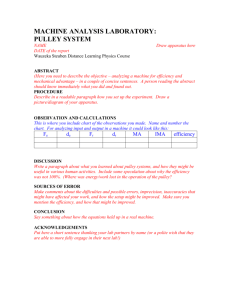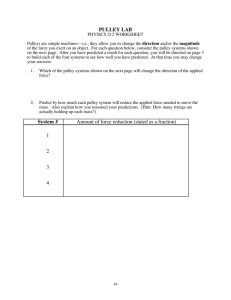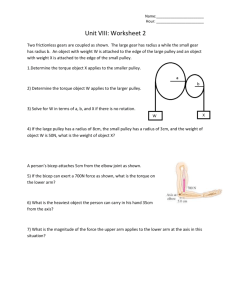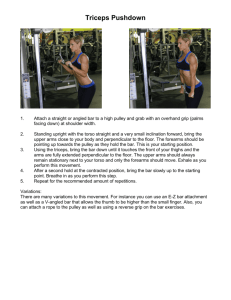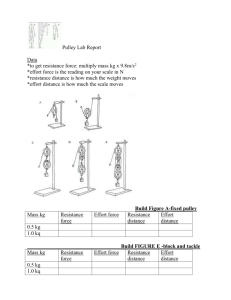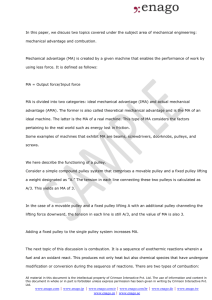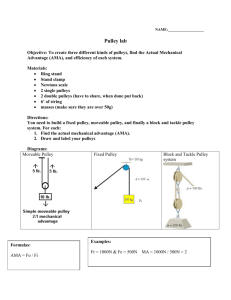Pulley System
advertisement
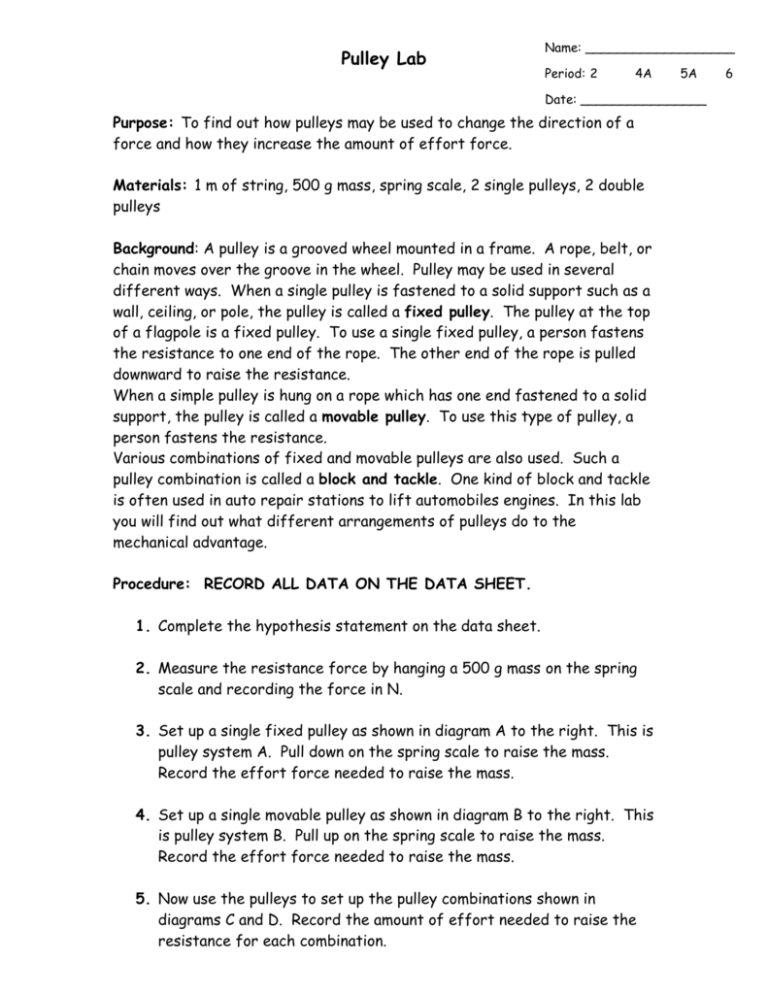
Pulley Lab Name: ___________________ Period: 2 4A 5A Date: ________________ Purpose: To find out how pulleys may be used to change the direction of a force and how they increase the amount of effort force. Materials: 1 m of string, 500 g mass, spring scale, 2 single pulleys, 2 double pulleys Background: A pulley is a grooved wheel mounted in a frame. A rope, belt, or chain moves over the groove in the wheel. Pulley may be used in several different ways. When a single pulley is fastened to a solid support such as a wall, ceiling, or pole, the pulley is called a fixed pulley. The pulley at the top of a flagpole is a fixed pulley. To use a single fixed pulley, a person fastens the resistance to one end of the rope. The other end of the rope is pulled downward to raise the resistance. When a simple pulley is hung on a rope which has one end fastened to a solid support, the pulley is called a movable pulley. To use this type of pulley, a person fastens the resistance. Various combinations of fixed and movable pulleys are also used. Such a pulley combination is called a block and tackle. One kind of block and tackle is often used in auto repair stations to lift automobiles engines. In this lab you will find out what different arrangements of pulleys do to the mechanical advantage. Procedure: RECORD ALL DATA ON THE DATA SHEET. 1. Complete the hypothesis statement on the data sheet. 2. Measure the resistance force by hanging a 500 g mass on the spring scale and recording the force in N. 3. Set up a single fixed pulley as shown in diagram A to the right. This is pulley system A. Pull down on the spring scale to raise the mass. Record the effort force needed to raise the mass. 4. Set up a single movable pulley as shown in diagram B to the right. This is pulley system B. Pull up on the spring scale to raise the mass. Record the effort force needed to raise the mass. 5. Now use the pulleys to set up the pulley combinations shown in diagrams C and D. Record the amount of effort needed to raise the resistance for each combination. 6 Calculations: Calculate the AMA, IMA and the % efficiency of each pulley system. Record these values on the data sheet. Hypothesis: If I use more pulleys, the mechanical advantage will (increase, decrease, stay the same). (Circle one) Record all your data in the chart below. Use a 500 g weight for the resistance. Pulley System Resistance (N) Effort (N) AMA (R ÷ E) IMA (number of supporting strings) % Efficiency AMA x 100 IMA Drawing of pulley system A B C D Pulley Lab Questions and Conclusions 1. Which of the pulley systems gave you the lowest mechanical advantage? 2. Which of the pulley systems gave you the highest mechanical advantage? 3. How did using several pulleys together affect the amount of effort needed to move the resistance? 4. Why does using both fixed and movable pulleys give you the maximum mechanical advantage? 5. In this lab, some pulleys were fixed and some were movable. Explain what these two terms mean when talking about pulleys.(The answer is NOT that one moves and the other doesn’t) 6. Which pulley system(s) had only movable pulleys? 7. Which pulley system had one fixed and one movable pulley? 8. Which pulley system had two fixed and one movable pulley? 9. How does the number of supporting strings affect the force needed to lift the resistance? 10. Do your results agree with your hypothesis? Explain using your data. 11. Draw a diagram of a pulley system that has 2 fixed and 2 movable pulleys. How many supporting strings are in this pulley system?
